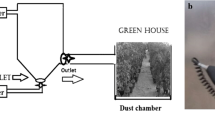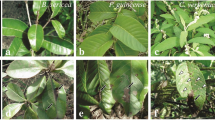Abstract
Stone crushing processes release particulates and associated noxious substances in our surroundings that are continuously destructing environmental conditions and ecosystem health. Morpho-anatomical changes in some medicinally important native species (Aerva javanica, Calotropis procera, Digera muricata, Euphorbia prostrata, Euploca strigosa, and Peganum harmala) exposed to heavy dust pollution were evaluated. These species selected on the basis of their ubiquitous distribution in the area. Two sites were selected in the Kirana Hills, Sargodha, one near stone crushers within 500-m radius (polluted) and the other 4 km away from the crushers (control) varying significantly in amount of dust particles received. A decrease in plant height of all species from dust-polluted sites was observed. Reduction in height was more prominent in species like C. procera and D. muricata. Stem sclerification increased in C. procera and E. prostrata from the polluted site that is an indication of better tolerance to dust pollution. C. procera showed increased stem and leaf epidermis, stem sclerenchyma, and stem vascular bundles, which can increase resistance to dust pollution. E. strigosa was the most sensitive species in which all morpho-anatomical factors decreased. Survival of plant species depended on specific structural modifications in dermal, mechanical, parenchymatous, and vascular tissue. Overall, dust pollution severely affected plant morphological and micro-morphological traits, but the response of selected species to dust pollution was variable. It is concluded that stem and leaf anatomical traits like size of dermal and storage tissue thickness and stomatal density are good indicators for biomonitoring of dust pollution.





Similar content being viewed by others
Data availability
The herbarium samples used for identification of plant species deposited to the Herbarium Collection of the Department of Botany, University of Agriculture Faisalabad.
References
Ade-Ademilua OE, Obalola DA (2008) The effect of cement dust pollution on Celosia argentea (Lagos spinach) plant. J Environ Sci Technol 1:47–55
Ahmad KS, Hameed M, Deng J, Ashraf M, Hamid A, Ahmad F, Fatima S, Akhtar N (2016) Ecotypic adaptations in Bermuda grass (Cynodon dactylon) for altitudinal stress tolerance. Biologia 71:885–895
Aminiyan MM, Baalousha M, Mousavi R, Aminiyan FM, Hosseini H, Heydariyan A (2018) The ecological risk, source identification, and pollution assessment of heavy metals in road dust: a case study in Rafsanjan, SE Iran. Environ Sci Pollut Res 25:13382–13395
Beckett KP, Freer-Smith PH, Taylor G (2000) Particulate pollution capture by urban trees effect of species and wind speed. Glob Chang Biol 6:995–1003
Braun M, Margitai Z, Tóth A, Leermakers M (2007) Environmental monitoring using linden tree leaves as natural traps of atmospheric deposition: a pilot study in Transilvania, Romania. Acta Geograph Debrecina Landsc Environ 1(1):24–35
Chaturvedi RK, Prasad S, Rana S, Obaidullah SM, Pandey V, Singh H (2013) Effect of dust load on the leaf attributes of the tree species growing along the roadside. Environ Monit Assess 185:383–391
Chaudhary IJ, Rathore D (2019) Dust pollution: its removal and effect on foliage physiology of urban trees. Sustain Cities Soc 51:101696
Dubey B, Pal AK, Singh G (2018) Airborne particulate matter: source scenario and their impact on human health and environment. In Climate Change and Environmental Concerns: Breakthroughs in Research and Practice, IGI Global, pp:447–468
El-Sherbeny GAA, Najm AA (2016) Physiological and anatomical behaviour of Cynanchum acutum in response to cement dust pollution. J Environ Sci Technol 9:345–353
Frosi G, Oliveira MT, Almeida-Cortez J, Santos MG (2013) Ecophysiological performance of C. procera: an exotic and evergreen species in Caatinga, Brazilian semi-arid. Acta Physiol Plant 35:335–344
Iqbal M, Iftikhar M, Ahmad MSA, Hameed M, Noreen A, Ikram M, Muneeb A, Ahmad I (2016) Vegetation dynamics of anthropogenically disturbed ecosystem in hilly areas around Sargodha, Pakistan. Int J Agric Biol 18:830–836
Inuwa Y, Mohammed MI (2018) Pollution indices and transfer factors of metals in selected medicinal herbs from Kano Metropolis. Discovery Sci 14:100–108
Jiménez MD, De Torre R, Mola I, Casado MA, Balaguer L (2018) Local plant responses to global problems: Dactylis glomerata responses to different traffic pollutants on roadsides. J Environ Manag 212:440–449
Joshi PC, Swami A (2009) Air pollution induced changes in the photosynthetic pigments of selected plant species. J Environ Biol 30:295–298
Kapoor CS (2014) Ficus benghalensis L. tree as an efficient option for controlling air pollution. Res Health Nutr 2:1–11
Khan I, Zhong N, Luo Q, Ai J, Yao L, Luo P (2020) Mineral composition and origin of organic matter input in Neoproterozoic–Lower Cambrian organic-rich shales of Salt Range Formation, upper Indus Basin, Pakistan. Int J Coal Geol 217:103319
Leghari SK, Zaid MA, Sarangzai AM, Faheem M (2013) Effect of road side dust pollution on growth and total chlorophyll contents in Vitis vinifera L.(grape). Afr J Biotechnol 13:1237–1242
Li SY, Man D, Li GD (2018) Ecological study of deterioration performance for concrete in saline soil environment. Ekoloji 27:659–666
Liu L, Guan D, Peart MR, Wang G, Zhang H, Li Z (2013) The dust retention capacities of urban vegetation—a case study of Guangzhou, South China. Environ Sci Pollut Res 20:6601–6610
Mehraj SS, Bhat GA (2014) Cement factories, air pollution and consequences. Jammu and Kashmir, India. Department of Environmental Science & Centre of Research for Development, University of Kashmir, Jammu and Kashmir, pp.30-36
Mickky BM, Abbas MA, El-Shhaby OA (2018) Alterations in photosynthetic capacity and morpho-histological features of leaf in alfalfa plants subjected to water deficit-stress in different soil types. Indian J Plant Physiol 23:426–443
Naidoo G, Chirkoot D (2004) The effects of coal dust on photosynthetic performance of the mangrove, Avicennia marina in Richards Bay, South Africa. Environ Pollut 127:359–366
Pal A, Kulshreshtha K, Ahmad KJ, Behl HM (2002) Do leaf surface characters play a role in plant resistance to auto exhaust pollution. Flora 197:47–55
Paull NJ, Krix D, Irga PJ, Torpy FR (2020) Airborne particulate matter accumulation on common green wall plants. Int J Phytoremed 22:594–606
Rahman MM, Rahman MA, Miah MG, Saha SR, Karim MA, Mostofa MG (2017) Mechanistic insight into salt tolerance of Acacia auriculiformis: the importance of ion selectivity, osmoprotection, tissue tolerance, and Na+ exclusion. Front Plant Sci 8:155
Rai A, Kulshreshtha K, Strivastava PK, Mohanty CS (2010) Leaf surface structure alterations due to particulate pollution in some common plants. Environmentalist 30:18–23
Rai PK, Panda LLS (2015) Roadside plants as bio indicators of air pollution in an industrial region, Rourkela, India. Int J Adv Res Technol 4:14–36
Rivas R, Frosi G, Ramos DG, Pereira S, Benko-Iseppon AM, Santos MG (2017) Photosynthetic limitation and mechanisms of photoprotection under drought and recovery of C. procera, an evergreen C3 from arid regions. Plant Physiol Biochem 118:589–599
Ruzin, 1999
Shah K, Ul Amin N, Ahmad I, Ara G (2018) Impact assessment of leaf pigments in selected landscape plants exposed to roadside dust. Environ Sci Pollut Res 25:23055–23073
Shah K, Ul Amin N, Ahmad I, Ara G Ur Rahman M, Zuo X, Xing L, Ren X (2019a) Cement dust induce stress and attenuates photosynthesis in Arachis hypogaea. Environ Sci Pollut Res 26:19490–19501
Shah K, Ul Amin N, Ahmad I, Ara G, Ren X, Xing L (2019b) Effects of chronic dust load on leaf pigments of the landscape plant Murraya paniculata. Gesunde Pflanzen 71:249–258
Simon E, Baranyai E, Braun M, Cserháti C, Fábián I, Tóthmérész B (2014) Elemental concentrations in deposited dust on leaves along an urbanization gradient. Sci Total Environ 490:514–520
Singh H, Sharma R, Sinha S, Kumar M, Kumar P, Verma A, Sharma SK (2017) Physiological functioning of Lagerstroemia speciosa L. under heavy roadside traffic: an approach to screen potential species for abatement of urban air pollution. Biotech 7:61
Thambavani SD, Prathipa V (2012) Biomonitoring of air pollution around urban and industrial sites. J Res Biol 1:7–14
Tiwari P, Pandey S (2017) Impact of cement dust pollution on leaf anatomical features of Lantana camara and Calotropis procera. Curr Sci Int 6:34–40
Wang HX, Shi H, Li YY (2010) Relationships between leaf surface characteristics and dust capturing capability of urban greening plant species. Chinese J. Appl Ecol 21:3077–3082
Wuytack T, Samson R, Wuyts K, Adriaenssens S, Kardel F, Verheyen K (2013) Do leaf characteristics of white willow (Salix alba L.), Northern red oak (Quercus rubra L.) and Scots pine (Pinus sylvestris L.) respond differently to ambient air pollution and other environmental stressors? Water Air Soil Pollut 224:1–14
Wuytack T, Wuyts K, Van Dongen S, Baeten L, Kardel F, Verheyen K, Samson R (2011) The effect of air pollution and other environmental stressors on leaf fluctuating asymmetry and specific leaf area of Salix alba L. Environ Pollut 159:2405–2411
Acknowledgments
This manuscript is a part of M.Phil. research of Miss Libaba Shamsi submitted to Department of Botany, University of Agriculture, Faisalabad.
Author information
Authors and Affiliations
Contributions
Iftikhar Ahmad, Mansoor Hameed, and Farooq Ahmad supervised the research work of Lubaba Shamsi. Sana Fatima, Anum Javaid, and Muhammad Asim Sultan helped in data collection and manuscript preparation. Muhammad Sajid Aqeel Ahmad analyzed the data statistically and performed the multivariate analysis. Muhammad Ashraf proofread the manuscript for language editing.
Corresponding author
Ethics declarations
Ethical approval
The manuscript submitted solely to Environmental Science and Pollution Research and no part published or submitted elsewhere. All ethical guidelines set by parent institution(s) were observed during sampling and analysis.
Consent to participate and publish
All authors equally participated in execution of experiment and unanimously agreed to publish in Environmental Science and Pollution Research.
Competing interests
The authors declare that they have no conflict of interest.
Additional information
Responsible Editor: Gangrong Shi
Publisher’s note
Springer Nature remains neutral with regard to jurisdictional claims in published maps and institutional affiliations.
Rights and permissions
About this article
Cite this article
Ahmad, I., Shamsi, L., Hameed, M. et al. Micro-morphological response of some native dicotyledonous species to particulate pollutants emitted from stone crushing activities. Environ Sci Pollut Res 28, 25529–25541 (2021). https://doi.org/10.1007/s11356-021-12463-2
Received:
Accepted:
Published:
Issue Date:
DOI: https://doi.org/10.1007/s11356-021-12463-2




